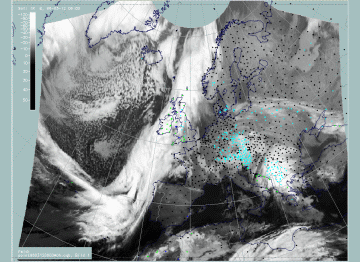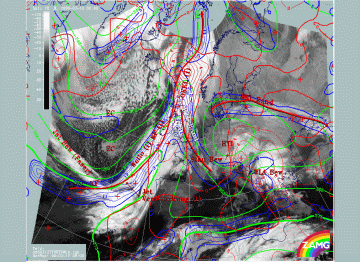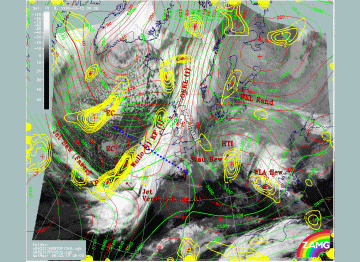12 March 1996 - Baroclinic Boundary To Upper Level Low
The discussion of this cloud feature is not intended to be a complete diagnosis of a Baroclinic Boundary but includes some discussions about different types of Warm Fronts.
|
12 March 1996/06.00 UTC - Meteosat IR image; weather events (green: rain and showers, blue: drizzle, cyan: snow, purple:
freezing rain, red: thunderstorm with precipitation, orange: hail, black: no actual precipitation or thunderstorm with
precipitation)
|
|
The cloud feature can be identified as a band-like structure extending with cyclonic curvature from south England across Belgium and France to the Alps where it has some connection with a cloud spiral over Austria. It consists of cloudiness with lower tops which are non-precipitating.
|
12 March 1996/06.00 UTC - Meteosat IR image; red thick: front indicator, red: height contours 1000 hPa, green: height contours 500 hPa,
yellow: positive vorticity advection (PVA) 500 hPa, SatRep overlay: names of conceptual models, position of vertical cross section
indicated
|
12 March 1996/06.00 UTC - Meteosat IR image; red thick: front indicator, blue: thermal front parameter (TFP) 500/850 hPa, green:
equivalent thickness 500/850 hPa, red: temperature advection - WA 1000 hPa, SatRep overlay: names of conceptual models
|
The inspection of the height levels represented by 1000 hPa close to the surface and by 500 hPa in upper levels clearly shows that this cloud structure is in a transition area between the trough region of the front and a completely different regime east of it. This regime represents an intensive upper level low with a centre over south Germany, but in the lower surface level merely a stream from the east bending to the north in the area of the Baroclinic Boundary as well as the main Cold Front. As indicated by the yellow lines, there exists a maximum of PVA on the rear side of the band.
Although the cloudiness originates in the main cloud band, it cannot be analysed as a Warm Front because it leaves the influence of this synoptic regime very soon and becomes related to the south-western part of the huge Upper Level Low. This is clearly confirmed by the thickness and the TFP, (green and blue lines), which both show the cyclonic curvature connected with the Upper Level Low. This would be very untypical for a Warm Front connected with the main Cold Front.
Another parameter that supports this assumption is temperature advection (red lines). There is no WA maximum superimposed on the cloud band in front of the TFP but rather CA which is concentrated in the western and central part of the upper level low. WA can only be found within the main Cold Front band and, as is usual, on the eastern half of the Upper Level Low.
Consequently, this substructure connected with the main Cold Front band seems to be a separate cloud feature which is not predominately influenced by the physical state of the frontal system Instead, it forms the Baroclinic Boundary to the Upper Level Low, which of course is responsible for the formation of a distinct thickness gradient between the thickness ridge ahead of the main Cold Front and the minimum of the Upper Level Low. Cloudiness forming in this front - like zone undergoes the cyclonic circulation of the Upper Level Low.


